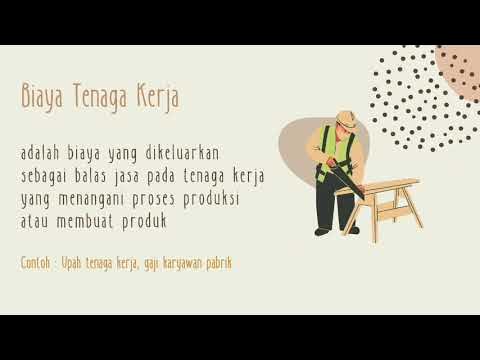KALKULASI BIAYA DAN LABA RUGI / AKUNTANSI MANAJEMEN PERTEMUAN 3
Summary
TLDRIn this video, the speaker explains the third meeting on cost and profit and loss calculations, providing an overview of key concepts like material usage, production costs, factory overhead, and the calculation of profits. Using practical examples from PT Sabar's 2015 data, the speaker guides viewers through the steps of calculating production costs, marketing costs, and profit margins. The discussion includes both the functional management and contribution margin models, offering a clear breakdown of fixed and variable costs to calculate net profit. Viewers are encouraged to review additional materials and contact the speaker for further clarification.
Takeaways
- 😀 Understanding cost and profit/loss calculations is essential in financial accounting, including material usage, production costs, and marketing expenses.
- 😀 Material usage is calculated by adding the initial raw material inventory to purchases and subtracting the final raw material inventory.
- 😀 Direct raw material costs, direct labor costs, and factory overhead are essential components in calculating production costs.
- 😀 The cost of production includes raw material usage, direct labor, factory overhead, and product inventories at the beginning and end of the process.
- 😀 To calculate the cost of goods sold (COGS), add the cost of production to the initial finished product inventory and subtract the final finished product inventory.
- 😀 Marketing costs are split into fixed and variable categories, which impact overall profit/loss calculations.
- 😀 The functional model of profit and loss calculation involves categorizing costs into functional areas (e.g., cost of goods sold, marketing costs).
- 😀 The contribution margin model of profit and loss calculation focuses on separating fixed and variable costs to assess profitability.
- 😀 Both the functional model and the contribution margin model ultimately lead to the same net profit, but the approach to cost allocation differs.
- 😀 The independent tasks involve applying the above concepts to new scenarios and ensuring a deeper understanding of cost and profit/loss calculations.
Q & A
What is the main focus of the third meeting discussed in the video?
-The main focus is on cost and profit/loss calculations, including material usage, production costs, marketing costs, and how to calculate profit and loss using two models.
How can the viewer adjust the speed of the video for better understanding?
-The viewer can adjust the speed by clicking on the speed setting option on YouTube and lowering it from normal speed.
What are the learning objectives mentioned in the video?
-The learning objectives are to understand cost calculation, factory cost calculation, marketing costs, and profit and loss calculations.
What is the importance of reading the provided theory in the material?
-The theory provides a concise and clear overview of the topics. While the video presents a brief summary, viewers are encouraged to study further from various sources to gain a deeper understanding.
What data is needed to calculate the cost of material usage?
-The data needed includes the initial raw material inventory, final raw material inventory, and raw material purchases. The formula is: (initial + purchases - final) = raw material usage.
How is the direct labor and factory overhead cost calculated?
-Direct labor and factory overhead costs are added together. In the video, the sum of 908 and 850 results in a total of 2850.
What is the process to calculate the cost of production?
-To calculate the cost of production, you add the calculated production costs to the product inventory at the beginning of the process and subtract the final product inventory.
What is the formula for calculating the cost of goods sold?
-The cost of goods sold is calculated by adding the initial finished product inventory to the cost of production and subtracting the final finished product inventory.
How is the marketing cost calculated in the examples presented?
-The marketing cost is provided as 600 in the example, and it is broken down into fixed and variable percentages, where 60% is fixed and 40% is variable.
What are the two profit and loss models discussed in the video?
-The two models are the functional model and the contribution margin model. Both are used to calculate profit and loss but involve different approaches, such as separating fixed and variable costs in the contribution margin model.
Outlines

Этот раздел доступен только подписчикам платных тарифов. Пожалуйста, перейдите на платный тариф для доступа.
Перейти на платный тарифMindmap

Этот раздел доступен только подписчикам платных тарифов. Пожалуйста, перейдите на платный тариф для доступа.
Перейти на платный тарифKeywords

Этот раздел доступен только подписчикам платных тарифов. Пожалуйста, перейдите на платный тариф для доступа.
Перейти на платный тарифHighlights

Этот раздел доступен только подписчикам платных тарифов. Пожалуйста, перейдите на платный тариф для доступа.
Перейти на платный тарифTranscripts

Этот раздел доступен только подписчикам платных тарифов. Пожалуйста, перейдите на платный тариф для доступа.
Перейти на платный тарифПосмотреть больше похожих видео

Biaya Produksi - Materi PKK Kelas XI || Production Cost

PKWU X | PERHITUNGAN BIAYA PRODUKSI PRODUK KERAJINAN

Menghitung Harga Pokok Produksi - Part 1

Menghitung Harga Pokok Produksi | Kewirausahaan Kelas 10

PKWU Kelas XII - Biaya Produksi, Harga jual dan Perhitungan laba Rugi || Seri Pembelajaran Daring

Orçamento de Produção
5.0 / 5 (0 votes)
